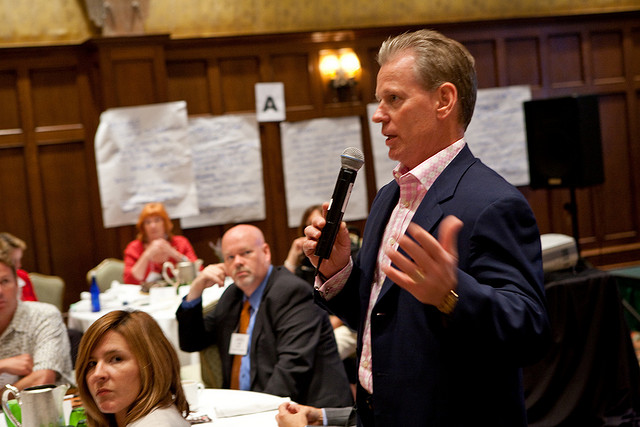
The Six Steps of Leadership (Plus Courage)
The Six Steps of Leadership (Plus Courage) https://csuiteold.c-suitenetwork.com/wp-content/uploads/2014/11/3694402368_43d5f517a4_z.jpg 640 427 C-Suite Network https://csuiteold.c-suitenetwork.com/wp-content/uploads/2014/11/3694402368_43d5f517a4_z.jpgby G.J. Hart
I worked at a poultry processing plant during college. I worked my way up and became general manager of the plant when I was 21, overseeing 500 people. I had done pretty much every role in the operation. That was a big advantage — knowing and living what people do every day. That allows me to understand people and help them grow. I like to say that leadership is about getting people to exceed their own expectations. You can’t do that unless you understand what they do and how they do it, having lived some of it yourself.
One thing I’ve learned over time is a lot more patience and tolerance. I used to always want things yesterday and would be very anxious about moving things along faster. But now I understand that tomorrow’s another day and things will move along. I think more about whether something really matters and how it will make a difference, versus thinking that everything matters and everything makes a difference. It’s also much clearer to me now what the leadership qualities are that are most important to me.
I call them the six steps of leadership, surrounded by courage. Courage is an interesting one because any leadership role is about stepping out and having the courage to be different— because you have to be different to be a leader.
- The first step is to be the very best that you can be, because you can’t lead anybody if you can’t lead yourself. So you have to be honest with yourself about your good qualities, your bad qualities and the things you need to work on.
- The second thing is to dream, and dream big. What’s the world of possibilities for yourself and for your organization? You have to be able to say, “Here’s where I want to get to.” It’s not that you’ll ever necessarily get there, but if you don’t dream, you’ll never even get started.
- The third is to lead with your heart first. Let people see that you’re human and that there’s a human side. Show people that you have compassion. It doesn’t mean that you don’t set expectations and standards. But if you lead with your heart, people figure out whether you’re genuine, whether you’re real.
- The fourth thing can be the hardest for young leaders: to trust the people you lead. It’s about letting go and allowing people to grow into leadership roles. At the end of the day, it’s OK if they make a mistake or if they fall down. Because as leaders, it’s your job to pick them back up.
- The fifth is do the right thing, always. It’s easy to say. But the way I like to describe it is that if the rules say one thing, particularly as it relates to people, and you genuinely believe in that person, sometimes it takes courage to do the right thing and give that person a second chance. Because we’ve all made mistakes, and somebody picked us up.
- The sixth is that it’s ultimately about serving the people you lead. It’s about putting the cause before yourself and a willingness to see it through. I developed this list over time because it’s the way I live each day. My job is to lead and to make a difference. I’m a catalyst for change, to create an environment where people can grow and prosper.
*This article originally appeared as an interview in the New York Times
 G.J Hart, Chairman, CEO and President of California Pizza Kitchen, is a highly respected industry leader who brings to CPK a proven track record of growing casual dining concepts. He most recently was CEO of Texas Roadhouse, a publicly traded casual-dining company that owns, operates, and franchises more than 350 restaurants across the country. His achievements have been recognized by leading media publications and industry organizations, including IR Magazine as one of its top CEOs (2011) and the Kentucky Restaurant Association as the Restaurateur of the Year (2010).
G.J Hart, Chairman, CEO and President of California Pizza Kitchen, is a highly respected industry leader who brings to CPK a proven track record of growing casual dining concepts. He most recently was CEO of Texas Roadhouse, a publicly traded casual-dining company that owns, operates, and franchises more than 350 restaurants across the country. His achievements have been recognized by leading media publications and industry organizations, including IR Magazine as one of its top CEOs (2011) and the Kentucky Restaurant Association as the Restaurateur of the Year (2010).




